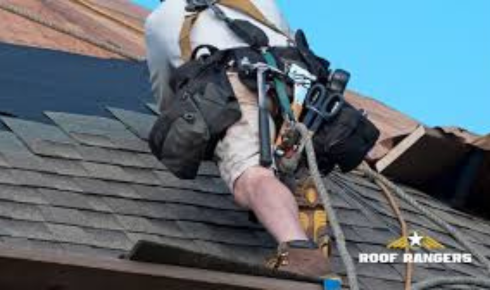In the world of roofing, proper bedding and pointing are crucial components in ensuring a leak-free and durable roof. Roof Ranger’s expert techniques in bedding and pointing play a vital role in maintaining the integrity of roofs, protecting homes from water damage and prolonging the lifespan of roofing systems.
Roof Rangers offers unparalleled expertise in roofing solutions, ensuring precise bedding and pointing. Their professional services enhance roof durability, prevent leaks, and safeguard against water damage. With cutting-edge techniques, they consistently deliver high-quality results that extend the lifespan of roofing systems, making them the trusted choice for homeowners.
Importance of Proper Bedding and Pointing
Proper bedding and pointing are essential aspects of masonry construction that play a crucial role in the structural integrity and longevity of a building. Bedding refers to the material, such as mortar, used to support and level the base of masonry units, such as bricks or stones. It provides a stable foundation for the masonry units to rest upon, ensuring even weight distribution and preventing settlement over time. Proper bedding helps to distribute loads evenly, reducing the risk of cracks and failures in the masonry structure. It also helps to maintain the alignment and levelness of the masonry units, contributing to the overall aesthetics of the building.
Pointing, on the other hand, refers to the technique of finishing the joints between masonry units with mortar. Pointing not only enhances the appearance of the masonry work but also serves important functional purposes. It helps to protect the masonry units from moisture infiltration, preventing water damage and deterioration. Proper pointing also helps to maintain the structural integrity of the masonry wall by providing additional support and stability to the overall structure. By ensuring that the joints are properly filled and sealed, pointing helps to improve the weather resistance and durability of the masonry construction, extending its lifespan and reducing maintenance costs in the long run.
Understanding Roof Leakage Issues
Understanding roof leakage issues is crucial for homeowners to prevent costly damages and maintain the structural integrity of their homes. Roof leaks can be caused by a variety of factors, including damaged or missing shingles, aging roofing materials, improper installation, clogged gutters, and flashing issues. Identifying the source of a roof leak can be challenging, as water can travel along rafters and beams before dripping down into the interior of the home. It is essential for homeowners to regularly inspect their roof for signs of damage, such as water stains on ceilings, damp spots on walls, or missing shingles. By addressing roof leakage issues promptly, homeowners can prevent water damage to their homes’ interior, insulation, and electrical systems.
To effectively address roof leakage issues, homeowners should consider hiring a professional roofing contractor to conduct a thorough inspection and identify the root cause of the problem. Roofing experts have the knowledge, experience, and equipment to assess the condition of the roof, pinpoint areas of concern, and recommend appropriate solutions. Depending on the severity of the leak, repairs may involve replacing damaged shingles, resealing flashing around vents and chimneys, clearing debris from gutters, or even replacing the entire roof. Taking proactive measures, such as keeping gutters clean, trimming overhanging tree branches, and scheduling regular roof maintenance, can help prevent roof leaks and extend the lifespan of the roof. By understanding roof leakage issues and investing in preventive maintenance, homeowners can protect their homes from water damage and costly repairs.
Roof Ranger Gutter Cleaning offers professional services to maintain the effectiveness of your gutters, preventing water damage and roof leaks. Visit their website at https://roofranger.com.au/gutter-cleaning/ for more information. Regular gutter maintenance is crucial for preventing roof issues, as clean gutters ensure proper water drainage and help protect your home.
Benefits of Quality Roof Bedding
Quality roof bedding offers several benefits that can help prolong the lifespan of a roof and enhance the overall structural integrity of a building. One of the key advantages of using high-quality roof bedding is its ability to provide a secure base for roof tiles or shingles. Properly installed roof bedding helps to evenly distribute the weight of the roofing materials, reducing the risk of damage or displacement during extreme weather conditions such as strong winds or heavy rain. This can prevent water infiltration and leaks, which can lead to costly repairs and structural damage over time. Additionally, quality roof bedding can improve the overall aesthetics of a roof by ensuring a uniform and neat appearance, enhancing the curb appeal of the building.
Furthermore, quality roof bedding can help to improve the energy efficiency of a building. By creating a tight seal between the roof tiles or shingles and the underlying structure, roof bedding can prevent air leakage and heat loss. This can result in lower energy bills as the building’s heating and cooling systems do not have to work as hard to maintain a comfortable indoor temperature. Additionally, properly installed roof bedding can help to reduce the risk of moisture buildup in the roof structure, which can lead to mold growth and rotting. Overall, investing in quality roof bedding can provide long-term cost savings, improve comfort levels inside the building, and contribute to a healthier indoor environment.
Role of Pointing in Roof Maintenance
Pointing, also known as repointing, plays a crucial role in roof maintenance by ensuring the integrity and longevity of a building’s structure. Pointing involves the process of repairing or replacing the external mortar joints between bricks or stones in a roof. Over time, these mortar joints can deteriorate due to exposure to weather elements, leading to water penetration, leaks, and structural damage. Proper pointing helps to seal any gaps or cracks in the joints, preventing water infiltration and enhancing the roof’s waterproofing capabilities. By maintaining the integrity of the mortar joints, pointing contributes to the overall stability and durability of the roof, protecting the building from potential water damage and structural issues.
Furthermore, pointing in roof maintenance helps to enhance the aesthetic appeal of a building by restoring the original look of the roof. Weathering and wear and tear can cause the mortar joints to deteriorate, leading to a worn-out and unkempt appearance. Repointing the roof with fresh mortar not only improves its structural integrity but also revitalizes its visual appeal. Properly done pointing can bring back the original charm of a building, making it look well-maintained and aesthetically pleasing. In addition to protecting the building from water damage, pointing also contributes to its curb appeal, enhancing its overall value and attractiveness.
Common Causes of Roof Leaks
Roof leaks can be caused by a variety of factors, with one common cause being damaged or missing shingles. Over time, shingles can become cracked, curled, or completely detached due to exposure to harsh weather conditions or general wear and tear. When shingles are compromised, they can no longer effectively protect the underlying roof structure from water infiltration, leading to leaks. Another frequent culprit of roof leaks is improper installation or poor workmanship. If a roof is not installed correctly, such as with inadequate sealing around roof penetrations or flashing, it can create weak points where water can seep through and cause leaks. Additionally, improper ventilation in the attic can lead to moisture buildup, which can eventually find its way into the living space through the roof, causing leaks.
Clogged gutters and downspouts are another common cause of roof leaks. When gutters become clogged with debris like leaves, twigs, and dirt, water is unable to flow freely off the roof, leading to standing water that can seep under the shingles and cause leaks. Poor gutter maintenance can also result in water overflowing the gutters and pooling along the roof edge, further increasing the risk of leaks. Additionally, flashing, which is used to seal joints and edges of the roof, can deteriorate over time due to exposure to the elements, leading to gaps where water can penetrate the roof system. Regular inspection and maintenance of gutters, flashing, and shingles are essential in preventing roof leaks caused by these common issues.
Techniques for Effective Bedding Application
Properly applying bedding to a bed is essential for a comfortable and restful sleep experience. One effective technique for bedding application is to start by laying the fitted sheet evenly over the mattress, ensuring that it is tightly secured on all corners to prevent it from slipping off during the night. Next, the flat sheet can be placed on top, making sure it is centered and evenly tucked in on all sides to avoid any wrinkling or discomfort. Adding a light blanket or duvet on top can provide additional warmth and comfort, with the top sheet folded neatly over it for a clean and polished look. Finally, decorative pillows and shams can be arranged to add a touch of style and sophistication to the bed, creating a welcoming and inviting atmosphere in the bedroom.
Another technique for effective bedding application is to choose materials and fabrics that are suited to the season and personal preferences. For warmer months, lightweight and breathable fabrics like cotton or linen can help regulate body temperature and promote a cooler sleeping environment. In contrast, for colder seasons, opting for flannel or fleece bedding can provide added warmth and coziness. Additionally, incorporating layers such as a quilt or throw blanket can offer flexibility in adjusting to changing temperatures throughout the night. By selecting bedding materials that are comfortable and appropriate for the climate, individuals can enhance their sleep quality and overall well-being.
Materials Used in Roof Bedding and Pointing
Roof bedding and pointing are essential processes in ensuring the longevity and structural integrity of a roof. The materials used in these tasks play a crucial role in providing a weatherproof and secure seal between the roof tiles or slates. One common material used in roof bedding is a mix of sand and cement. This mixture is applied between the roof tiles and the roof structure to create a solid and stable foundation. Sand provides the necessary bulk and helps in binding the mixture, while cement offers strength and durability to withstand the elements. This traditional method has been used for years and is known for its reliability and effectiveness in securing roof tiles in place.
In addition to sand and cement, another commonly used material in roof bedding and pointing is a flexible pointing compound. This compound is a premixed blend of sand, cement, and polymers that offers greater flexibility and adhesive properties compared to traditional mortar. The flexibility of the compound allows for natural movement and settlement of the roof structure without compromising the seal. The polymers enhance the strength and water resistance of the compound, making it ideal for use in areas prone to extreme weather conditions. Flexible pointing compounds come in a variety of colors to match the roof tiles, providing a seamless and aesthetically pleasing finish to the roof bedding and pointing process.
Signs That Your Roof Needs Re-Bedding
1. One of the key signs that your roof needs re-bedding is the presence of loose or missing roof tiles. Over time, the mortar that holds the roof tiles in place can deteriorate due to exposure to the elements. This can cause the tiles to become loose or even dislodged, leaving gaps where water can seep through and cause damage to your roof structure. If you notice any loose or missing tiles on your roof, it is a clear indication that re-bedding is necessary to secure the tiles back in place and prevent further damage.
2. Another sign that your roof requires re-bedding is the appearance of cracks or gaps in the mortar that holds the roof ridge caps in place. The ridge caps are the tiles that run along the peak of your roof, providing a protective barrier against water infiltration. If the mortar holding the ridge caps in place starts to crack or crumble, it can compromise the integrity of your roof and make it more susceptible to leaks. By inspecting the condition of the mortar on your ridge caps, you can determine if re-bedding is needed to reinforce this critical part of your roof structure and ensure its longevity and effectiveness in protecting your home.
DIY Tips for Roof Bedding and Pointing
Roof bedding and pointing are crucial aspects of maintaining a sturdy and watertight roof. When it comes to tackling these tasks as a DIY project, there are several key tips to keep in mind. Firstly, before starting any work, thoroughly inspect the roof for any damaged or deteriorated bedding and pointing material. This may involve removing any loose or cracked mortar to ensure a clean and stable base for the new material to adhere to. It is important to use the correct type of mortar for the specific roofing material being worked on, as using an incompatible mortar can lead to premature failure and water leaks.
Next, when applying the new bedding and pointing material, ensure that it is done carefully and evenly to create a strong seal that will withstand the elements. Take your time to pack the mortar firmly into the joints and smooth it out to create a neat finish. It is also important to pay attention to the weather conditions when undertaking roof bedding and pointing, as extreme temperatures or rain can affect the curing process of the mortar. Finally, once the bedding and pointing are complete, regularly inspect the roof for any signs of wear or damage, and address any issues promptly to prevent further deterioration and potential leaks.
Hiring a Professional Roof Ranger: What to Look For
When hiring a professional roof ranger, there are several key factors to consider to ensure you are choosing the right contractor for the job. First and foremost, make sure the roof ranger is licensed and insured. This not only ensures that the contractor is qualified to work on your roof but also provides you with protection in case of any accidents or damages during the project. Additionally, look for a roof ranger with a solid reputation in the industry. Check online reviews, ask for references, and inquire about their experience and track record with similar projects. A reputable roof ranger will have a portfolio of successfully completed jobs and satisfied customers to showcase their expertise.
Another important aspect to consider when hiring a professional roof ranger is their knowledge and expertise in the specific type of roofing you have. Whether it’s shingles, metal, tile, or flat roofing, make sure the contractor has experience working with that material and can provide the necessary skills and techniques for a quality installation or repair. Communication is also key when working with a roof ranger, so choose a contractor who is responsive, transparent, and willing to answer any questions you may have throughout the project. By carefully considering these factors, you can ensure that you hire a professional roof ranger who will deliver high-quality work and peace of mind for your roofing project.





